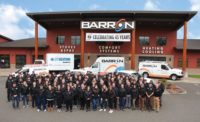Customers are key components to business. Without them, products, services, and training go to waste. The idea that there is an ideal HVACR customer waiting to be discovered may seem absurd, but according to Justin Jacobs, marketing coach for Hudson Ink, finding the right customers for contractors depends on the bait that is used.
“When you’re fishing for a certain type of fish and wanting to increase the odds of catching that type while weeding out the others, you must fish in specific places with specific lures,” he said. “That starts with studying the target. You must know where they live and what they are attracted to in order to be most successful.”
For Rich Morgan, president of Magic Touch Mechanical Inc. in Mesa, Arizona, this means creating an avatar or representation of the epitome of the ideal customer. The concept of an ideal customer changes for individual contractors and business sectors, i.e. residential and commercial, but according to Morgan, time and experience have allowed him to identify the ideal customer for his business goals.
“We have multiple avatars based on different products and services,” he said. “Knowing that, we want to make sure we are reaching them through the proper media, with the proper message, at the proper time.”
Magic Touch uses specifically designed mass marketing.
“Ultimately, it’s impossible to reach only our ideal customer when mass marketing,” he said. “But after marketing has attracted the leads, our customer service representatives use a process to convert them into customers and detract those who aren’t.”
In creating avatars specific to a contractor’s company, Jacobs suggests using the customer data from the company and making a list of its 50 best current customers. According to him, these customers are the ones who buy repeatedly, use more than one service from the company, don’t beat the contractor up on price, and rarely have complaints unless warranted.
“When contractors take their top 50 customers and develop a profile, they’re likely to find a lot of similarities,” said Jacobs. “Those commonalities are extremely valuable knowledge and useful to target others in the area that fit that mold.”
Jacobs refers to this process as building a customer avatar as well, and he explained that contractors would likely find that a good piece of their revenue is actually coming from just a handful of neighborhoods that have similar household income ranges and possibly similar age demographics as well.
CHOOSING PROFITABLE CUSTOMERS
After contractors identify the ideal avatars for their businesses, marketing makes it possible to choose customers from the mass of potential targets. Despite having the phone ring more with less targeted marketing campaigns, a targeted campaign can provide contractors a direct link to their ideal customers. Jacobs cautioned contractors that having the phone ring constantly with leads is not a measure of success in a marketing campaign.
“Sure, everyone wants the phone ringing off the hook, but if most of those customers are essentially wasting your time, then being covered in leads might even be costing you money,” he said. “There will always be price shoppers, people who can’t get financing, goose chases on estimates, and others who just want to pick an expert’s brain and then try to do the job themselves.
“But you can’t sell to people who don’t have money unless you are willing to give your services away for free,” Jacobs added. “That sounds bad, but it’s not untrue, and I don’t know many contractors operating under a 501(c)(3).”
David Squires, president of Online-Access and co-owner of Vincent’s Heating and Plumbing in Port Huron, Michigan, defines a bad client using three characteristics: customers who are only concerned with price, customers who are abusive to his employees, and customers who are unreasonable or refusing to be satisfied.
“Unfortunately, the only one that I have potential to limit my exposure to is the customer only concerned about price,” said Squires. “That type of person is easy to filter out by simply making your marketing not about price. The other two conditions that I use to define a bad customer are just occupational hazards. We give them their money back, so they can be someone else’s customer.”
Squires bases his quest for good customers on what he considers the golden rule of marketing: people do business with people they like.
To do this, he advises contractors to engage in the community, work with local charities, and create ongoing communication through a unique newsletter.
“Our newsletter is custom built and involves owner-written articles with our perceptions and beliefs as to how they relate to how we operate our business,” said Squires. “We have found that our customers relate to us better through our transparency.”
Jacobs agrees that newsletters, social interaction, and holiday cards that aren’t trying to sell something are good ways to connect with customers.
“You consider all those names in your database to be your customers,” he said. “Find ways to make them consider you to be their contractor, and the good ones will stick around, getting better and more profitable as time goes by.”
CONSEQUENCES MAY VARY
Although Squires sees value in filtering out some customers that can be detrimental to his business, he cautions contractors about the risk of potentially losing a good customer by applying a blanket filter to their customer databases.
“The truth is that it’s rare that customers are ‘born bad,’ and we as contractors need to take responsibility for creating a good portion of them,” he said. “We typically create them because we fail to discover and manage their expectations before we complete the job.”
Lauren Smith is the marketing coordinator for One Hour Heating & Air Conditioning in Virginia Beach, Virginia. She considers every customer to be ideal, and according to her, so does the team she works with.
“What we do is tell our story about who we are,” said Todd Kletz, owner and general manager of One Hour Heating & Air Conditioning. “I believe that if we remain true to ourselves and what we deliver aligns with what the customer wants, we have a win. So the real question is, ‘Are we the ideal company for the client?’”
Smith cautioned contractors against getting carried away identifying an ideal customer and targeting only specific types of people when marketing. She explained that this practice is a good way to miss out on potential business opportunities.
“There is a lot of value in getting your message out to every type of customer, especially in the heating and air conditioning industry,” said Smith. “Word-of-mouth is still the most valuable form of marketing, and in our digital world, news travels fast. We are also happy to help anyone who is deemed ‘not ideal’ by another company.”
Publication date: 1/14/2019
Want more HVAC industry news and information? Join The NEWS on Facebook, Twitter, and LinkedIn today!











